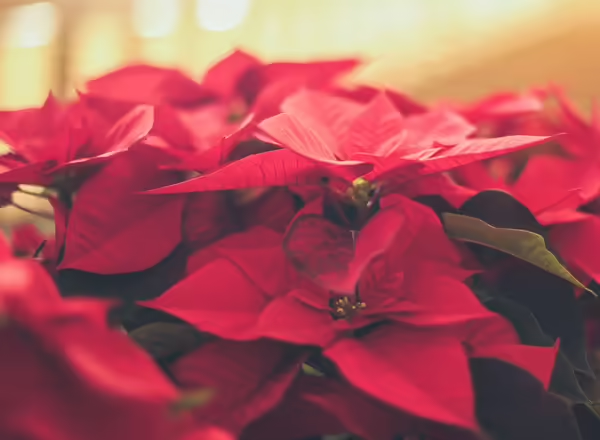
Caring for Poinsettias
The length of time your Poinsettia will give you pleasure in your home depends on the maturity of the plant, when you buy it, and how you treat the plant. With care, poinsettias should retain their beauty for weeks, and some varieties will stay attractive for months.
- After making your Poinsettia selection, ensure it is wrapped properly because exposure to low temperatures even for a few minutes can damage the bracts and leaves.
- Unwrap your Poinsettia carefully and place in indirect light. Six hours of light daily is ideal. Keep the plant from touching cold windows.
- Do not place Poinsettias near heating vents or doors. Poinsettias stay the freshest in a cool room, away from drafts. Temperatures should be no lower than 55°F and no higher than 70°F. The ideal temperature to keep these plants healthy and colors more vibrant is 65°F.

- Ideally Poinsettias require daytime temperatures of 60 to 70°F and night time temperatures around 55°F. High temperatures will shorten the plant’s life. Move the plant to a cooler room at night, if possible.
- Check the soil daily. Be sure to punch holes in foil so water can drain into a saucer. Water when soil is dry. Allow water to drain into the saucer and discard excess water. Wilted plants will tend to drop bracts sooner.
- Fertilize the Poinsettia if you keep it past the holiday season. Apply a houseplant fertilizer once a month. Do not fertilize when it is in bloom.
- With good care, a Poinsettia will last 6 to 8 weeks in your home.
While most people dispose of poinsettias after they finish blooming, with a little effort it is possible to get a poinsettia to bloom again next year.
Once about half of the leaves and bracts have dropped, start to decrease watering until the soil is completely dry. This will cause the plant to go dormant. Store the dormant plant in a cool, dark location, watering only enough to prevent the stems from shriveling. Once new growth begins, usually in early May, cut the plant to within 4 to 6 inches of the soil; this will help encourage new growth. If you wish to repot the plant, now is the time to do that as well. Place the plant in a sunny window and treat it like any other houseplant, watering when dry and fertilizing occasionally with a dilute fertilizer.
Once the danger of frost has passed and nighttime temperatures remain above 50 degrees F, move your poinsettia outdoors, exposing it to direct sun gradually over a week or two to allow it to acclimate to the outdoors. Then dig a hole big enough to hold the pot in an area that receives 6 to 8 hours of direct sunlight, with some shade in the afternoon. Turn the pot occasionally to prevent your poinsettia from rooting through the bottom holes. If you can’t put the poinsettia pot in the ground, you may need to water the plant more frequently. To keep your poinsettia from getting too leggy, pinch off the shoot tips, choosing tips with two or three fully expanded leaves below them. Do this every three or four weeks until midAugust to keep the plant compact and bushy. Remember to water your poinsettia regularly, and fertilize it every couple of weeks.
When night temperatures get down to 55 to 60 degrees F, it’s time to bring your poinsettia back inside and place it in a sunny window. Poinsettias are short-day plants, meaning they grow vegetatively during times where there are long days and produce flowers when exposed to short days – or, more specifically, to long nights. For your plant to rebloom in time for Christmas, it needs to be in complete darkness from 5 pm to 8 am from about the end of September until the bracts develop good color, usually in early or mid-December. To provide darkness, place the plant in a closet or cover it with a box. During the day, put it back in the sunny window. Keep up this routine until the bracts are almost fully expanded. Try to make sure the plant doesn’t experience temperatures below 60 or above 70 degrees F. Nighttime temperatures above 70 to 75 degrees F may delay or prevent flowering.